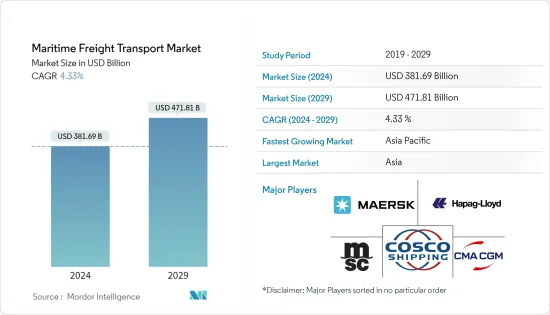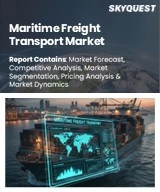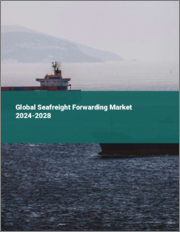
|
시장보고서
상품코드
1436007
해상 화물 운송 : 시장 점유율 분석, 업계 동향 및 통계, 성장 예측(2024-2029년)Maritime Freight Transport - Market Share Analysis, Industry Trends & Statistics, Growth Forecasts (2024 - 2029) |
||||||
해상 화물 운송 시장 규모는 2024년 3,816억 9,000만 달러로 추정되고, 2029년까지 4,718억 1,000만 달러에 이를 것으로 예측되며, 예측 기간(2024-2029년) 동안 4.33%의 연평균 복합 성장률(CAGR)로 성장할 전망입니다.

해상 화물 운송 업계는 세계 무역의 약 90% 운송을 담당하고 있습니다. 해상무역은 계속 확대되고 있으며 경쟁력 있는 운임비용을 통해 세계 소비자들에게 이익을 제공합니다. 운송수단으로서의 해운효율의 향상과 경제자유화의 추진에 의해 이 업계의 추가 성장 전망은 계속 강해지고 있습니다.
주요 수출입 무역을 포함한 모든 무역 체인이 파탄에 직면하고 있습니다. 이 역경의 시기와 상황의 긴급성으로 인해 다른 항구에서 운항되는 컨테이너 및 선박, 특히 중국에서 운송되는 컨테이너 및 선박의 입국이 각국에 의해 금지되었습니다.
50,000척 이상의 상선이 국제무역을 하고 있으며, 모든 유형의 화물을 운송하고 있습니다. 세계의 선단은 150개국 이상으로 등록되어 있으며 거의 모든 국적의 100만명 이상의 선원이 승무하고 있습니다.
구체적으로는 2022년 초 곡물 가격과 건식벌크 운임의 상승이 소비자 식품 가격의 1.2% 상승에 기여한 것으로 추정되고 있습니다. 2021년 컨테이너선의 항구 체류시간은 2020년에 비해 13.7% 길어 지연과 부족이 악화되었습니다. 작년 세계 선박의 온실가스 총 배출량은 4.7% 증가했습니다.
UNCTAD에 의한 해상 운송 검토라는 제목의 보고서에 따르면, 수년 동안 가장 빠르게 성장하는 분야는 컨테이너 무역이며 2023년 성장률은 1.9%를 나타낼 것으로 예상됩니다.
해상 화물 운송 시장 동향
컨테이너화는 동향으로 진화하고 있습니다.
UNCTAD(유엔무역개발회의)에 따르면 국제해상무역은 특히 컨테이너화물, 건식벌크화물, 가스화물의 성장에 의해 추진되고 있습니다. 그러나 지정학적 긴장과 신형 코로나바이러스 감염(COVID-19)과 같은 세계 팬데믹과 같은 불확실성은 여전히 현재 해상 수송 환경에서 최우선 주제이며 위험은 하향하고 있습니다.
일반화물의 컨테이너화에 대한 장기적인 추세는 상승의 경향이 있습니다. 세계화된 컨테이너 무역의 대부분은 계속해서 주요 동서 컨테이너화 무역 동맥, 즉 아시아-유럽, 환태평양 및 대서양을 가로질러 운반되었습니다. 컨테이너화 무역 및 건식벌크 무역은 예측 기간 동안 각각 4.5%와 3.9%의 연간 복합 성장률을 나타낼 것으로 예상됩니다.
현재 세계 1,700만 개 이상의 운송 컨테이너가 사용되고 있으며 컨테이너는 항상 진화하고 있습니다. 세계 무역이 급속히 확대됨에 따라 효율적인 화물 운송에 대한 수요도 높아지고 있습니다.
최초로 컨테이너가 표준화된 이후 수요 및 공급에 의해 성장과 변화가 촉진되어 왔지만, 컨테이너선에 탑재되는 컨테이너의 수에 영향을 미치는 요인은 그것만이 아닙니다. 수년에 걸친 컨테이너의 크기도 그 수에 영향을 미쳤습니다.
아시아태평양은 가장 급성장하는 시장
아시아태평양은 중국과 인도 등 세계에서 가장 빠르게 성장하는 경제 국가로 구성되어 있습니다. 무역교류는 이 나라에 의한 해운부문의 성장을 지지하고 있으며, 국제무역의 대부분은 해상 루트에서 이루어지고 있습니다.
세계의 컨테이너 항만 취급 활동의 동향은 세계 무역과 해운에서 아시아의 중심적인 역할도 부각하고 있습니다. 아시아 국가에서는 역내 무역이 크게 증가하고 있는데, 이는 주로 제조 무역을 기반으로 하며, 일반적으로 부품이 아시아의 여러 장소에서 제조되고 다른 장소에서 조립되는 단편적인 생산 공정를 반영합니다. 이에 따라 해상 운송으로 인한 무역 확대도 기대됩니다. 수요 증가는 주로 아시아에서 일어나고 있으며, 진행 중인 에너지 정책의 전환 및 호주와 미국의 수출 능력 증가로 뒷받침됩니다.
아시아태평양은 해상 화물 운송 시장에 상당한 선박 가치를 제공하는 주요 국가의 존재가 특징입니다. 중국, 일본, 싱가포르, 한국은 세계 선박 소유국의 10위를 차지하고 있습니다.
예를 들어, 2021년 1월 시점에서 중국의 함대 자산 총액은 1,960억 달러에 달했지만, 일본의 함대 자산 총액은 1,880억 달러, 싱가포르의 함대 자산 총액은 790억 달러, 한국의 함대 자산 총액은 596억 달러에 도달했습니다.
이러한 시장 외에도 인도, 인도네시아, 베트남, 말레이시아, 필리핀, 태국 등 해양 분석의 채택을 기대할 수 있는 몇몇 신흥국 시장이 있습니다. 국제통화기금(IMF)에 따르면 2022년 12월 현재 해상무역국 상위 10개국에는 중국, 한국, 말레이시아, 대만이 포함됐습니다.
해상 화물 운송 산업 개요
해운 시장은 상당히 집중되어 있으며 소수의 기업이 시장의 상당한 점유율을 차지합니다. 시장에서 유명한 기업으로는 MSC, COSCO, AP Moller 등이 있습니다.
해상 운송은 해운의 본질적인 국제성과 여러 이해 관계자의 측면으로 인해 복잡한 활동 분야입니다. 이 부문의 기업은 현재 이 부문이 이산화탄소 배출량과 환경오염에 대한 영향을 삭감하는 계획의 실시를 향해 움직이고 있기 때문에 2020년 1월부터 국제해사기관이 정하는 선박연료에 대한 세계 유황 상한선 인하를 준수하는 데 중점을 둡니다.
기타 혜택
- 엑셀 형식 시장 예측(ME) 시트
- 3개월의 애널리스트 서포트
목차
제1장 서론
- 조사의 전제 조건
- 조사 범위
제2장 조사 방법
- 분석 조사 방법
- 조사 단계
제3장 주요 요약
제4장 시장 역학 및 인사이트
- 현재의 시장 시나리오
- 시장 역학
- 성장 촉진요인
- 세계무역 증가
- 비용 효율적인 운송 수요
- 억제요인
- 시장 성장에 영향을 미치는 규제 증가
- 연료비 상승이 시장에 영향
- 기회
- 시장을 뒷받침하는 신기술의 이용
- 세계에서 높아지는 해상무역 수요
- 성장 촉진요인
- 업계의 매력-Porter's Five Forces 분석
- 신규 참가업체의 위협
- 구매자의 협상력
- 공급기업의 협상력
- 대체 제품의 위협
- 경쟁 기업간 경쟁 관계의 격렬
- 밸류체인 및 공급망 분석
- 기술의 진보
- 정부의 규제 및 주요 대처
- 픽업 무역에 대한 인사이트
- 컨테이너화 및 비컨테이너화 화물에 대한 인사이트
- 운임 및 해상 운송비
- 복합 일관 운송 및 컨테이너 이용에 관한 인사이트
- 수급 분석
- 시장에 대한 COVID-19의 영향
제5장 시장 세분화
- 유형별
- 컨테이너화
- 일반
- 냉동차
- 비컨테이너화
- 컨테이너화
- 지역별
- 북미
- 미국
- 캐나다
- 북미의 다른 지역
- 유럽
- 독일
- 러시아
- 프랑스
- 영국
- 기타 유럽
- 아시아태평양
- 중국
- 일본
- 호주
- 인도
- 기타 아시아태평양
- 중동 및 아프리카
- 사우디아라비아
- 남아프리카
- 기타 중동 및 아프리카
- 남미
- 브라질
- 콜롬비아
- 아르헨티나
- 기타 남미
- 북미
제6장 경쟁 구도
- 시장 집중도 개요
- 기업 프로파일
- AP Moller(Maersk)
- Mediterranean Shipping Company SA(MSC)
- CMA-CGM
- China Ocean Shipping(Group) Company(COSCO)
- Hapag-Lloyd
- ONE-Ocean Network Express
- Evergreen Line
- HMM Co. Ltd
- Yang Ming Marine Transport
- Zim
- Wan Hai Lines
- PIL Pacific International Line*
제7장 시장의 미래
제8장 부록
AJY 24.03.08The Maritime Freight Transport Market size is estimated at USD 381.69 billion in 2024, and is expected to reach USD 471.81 billion by 2029, growing at a CAGR of 4.33% during the forecast period (2024-2029).

The maritime freight transport industry is responsible for the carriage of around 90% of world trade. Seaborne trade continues to expand, bringing benefits for consumers across the world through competitive freight costs. Thanks to the growing efficiency of shipping as a mode of transport and increased economic liberalization, the prospects for the industry's further growth continue to be strong.
All the trade chains, including the major import and export trade, face a downfall. During this adverse time and the urgency of the situation, a ban had been imposed by various countries on the entry of containers and vessels that are being operated from other ports, especially those that are transported from China.
Over 50,000 merchant ships are trading internationally, transporting every kind of cargo. The world fleet is registered in over 150 nations and manned by over a million seafarers of virtually every nationality.
Concretely, it was estimated that higher grain prices and dry bulk freight rates in early 2022 contributed to a 1.2% increase in consumer food prices. Container ships spent 13.7% longer in port in 2021 compared to 2020, exacerbating delays and shortages. During the last year, total greenhouse gas emissions from the world fleet increased by 4.7%.
For many years, the fastest-growing segment was containerized trade, for which growth in 2023 is expected to reach 1.9%, according to a report titled Review of Maritime Transport by UNCTAD.
Maritime Freight Transport Market Trends
Containerization is Evolving as a Trend
According to UNCTAD (United Nations Conference on Trade and Development), international maritime trade is driven in particular by growth in containerized, dry bulk, and gas cargo. However, uncertainties like geopolitical tensions and global pandemics like COVID-19 remain an overriding theme in the current maritime transport environment, with risks tilted to the downside.
The long-term trend toward the containerization of general cargo is upward rising. A large share of globalized containerized trade continued to be carried across the major East-West containerized trade arteries, namely Asia-Europe, the Trans-Pacific, and the Transatlantic. Containerized and dry bulk trades are expected to register a compound annual growth rate of 4.5% and 3.9%, respectively, over the forecast period.
Today, over 17 million shipping containers are used worldwide, which is evolving constantly. With global trade expanding rapidly, the demand for efficient cargo transport will only grow as well.
Supply and demand have facilitated growth and change since the first standardized containers, but they're not the only factors that have impacted how many containers are on a container ship. The size of containers over the years has affected the number as well.
Asia-Pacific is the Fastest Growing Market
The Asian-Pacific region consists of some of the fastest-growing economies in the world, like China and India. The trade exchanges support this growth in the maritime transportation sector by these countries, of which the majority of international trade takes place via sea routes.
Trends in global container port-handling activities also highlight the central role of Asia in global trade and shipping. Asian countries are experiencing a large increase in intra-regional trade, mostly based on manufacturing trades and reflecting fragmented production processes, where parts are generally manufactured in multiple locations across Asia and assembled in another location. This is also expected to increase trade, supported by marine transportation. Demand growth originated mostly in Asia, bolstered by ongoing energy policy shifts and rising export capacity in Australia and the United States.
The Asia Pacific region is characterized by the presence of some major countries that contribute substantial fleet value to the maritime freight transport market. China, Japan, Singapore, and South Korea are among the top ten ship-owning countries worldwide.
For instance, as of January 2021, China's total fleet asset value reached USD 196 billion, whereas Japan's total fleet asset value reached USD 188 billion, Singapore's total fleet asset value was USD 79 billion, and South Korea's total fleet asset value reached USD 59.6 billion.
In addition to these markets, there are several other potential developing markets for the adoption of maritime analytics, such as India, Indonesia, Vietnam, Malaysia, the Philippines, and Thailand. As per the Internal Monetary Fund (IMF), in December 2022, the top 10 sea trading countries included China, South Korea, Malaysia, and Taiwan.
Maritime Freight Transport Industry Overview
The maritime transport market is fairly concentrated, with a few players accounting for significant amounts of shares in the market. Some of the prominent companies in the market are MSC, COSCO, and AP Moller.
Maritime transport is a complex activity area, owing to the inherently international nature of shipping and its multi-stakeholder dimension. The companies in the sector currently are focusing on complying with the International Maritime Organization's lower global sulfur cap on marine fuels from January 2020 as the segment moves towards implementing the plans to reduce its carbon footprint and contribution to pollution.
Additional Benefits:
- The market estimate (ME) sheet in Excel format
- 3 months of analyst support
TABLE OF CONTENTS
1 INTRODUCTION
- 1.1 Study Assumptions
- 1.2 Scope of the Study
2 RESEARCH METHODOLOGY
- 2.1 Analysis Methodology
- 2.2 Research Phases
3 EXECUTIVE SUMMARY
4 MARKET DYNAMICS AND INSIGHTS
- 4.1 Current Market Scenario
- 4.2 Market Dynamics
- 4.2.1 Drivers
- 4.2.1.1 Increasing global trade
- 4.2.1.2 Demand for cost-effective transportation
- 4.2.2 Restraints
- 4.2.2.1 Increasing regulations affecting the growth of the market
- 4.2.2.2 Surge in fuel costs affecting the market
- 4.2.3 Opportunities
- 4.2.3.1 Usage of new technologies boosting the market
- 4.2.3.2 Increasing demand for maritime trade across the globe
- 4.2.1 Drivers
- 4.3 Industry Attractiveness - Porter's Five Forces Analysis
- 4.3.1 Threat of New Entrants
- 4.3.2 Bargaining Power of Buyers/Consumers
- 4.3.3 Bargaining Power of Suppliers
- 4.3.4 Threat of Substitute Products
- 4.3.5 Intensity of Competitive Rivalry
- 4.4 Value Chain/Supply Chain Analysis
- 4.5 Technological Advancements
- 4.6 Government Regulations and Key Initiatives
- 4.7 Insights into Transshipment Trade
- 4.8 Insights into Containerized and Non-containerized Shipments
- 4.9 Freight Rates and Maritime Transport Costs
- 4.10 Insights into Intermodal/Container Utilization
- 4.11 Demand-Supply Analysis
- 4.12 Impact of COVID-19 on the Market
5 MARKET SEGMENTATION
- 5.1 By Type
- 5.1.1 Containerized
- 5.1.1.1 General
- 5.1.1.2 Reefer
- 5.1.2 Non-containerized
- 5.1.1 Containerized
- 5.2 By Geography
- 5.2.1 North America
- 5.2.1.1 United States
- 5.2.1.2 Canada
- 5.2.1.3 Rest of North America
- 5.2.2 Europe
- 5.2.2.1 Germany
- 5.2.2.2 Russia
- 5.2.2.3 France
- 5.2.2.4 United Kingdom
- 5.2.2.5 Rest of Europe
- 5.2.3 Asia-Pacific
- 5.2.3.1 China
- 5.2.3.2 Japan
- 5.2.3.3 Australia
- 5.2.3.4 India
- 5.2.3.5 Rest of Asia-Pacific
- 5.2.4 Middle East and Africa
- 5.2.4.1 Saudi Arabia
- 5.2.4.2 South Africa
- 5.2.4.3 Rest of Middle East and Africa
- 5.2.5 South America
- 5.2.5.1 Brazil
- 5.2.5.2 Colombia
- 5.2.5.3 Argentina
- 5.2.5.4 Rest of South America
- 5.2.1 North America
6 COMPETITIVE LANDSCAPE
- 6.1 Market Concentration Overview
- 6.2 Company Profiles
- 6.2.1 AP Moller (Maersk)
- 6.2.2 Mediterranean Shipping Company SA (MSC)
- 6.2.3 CMA-CGM
- 6.2.4 China Ocean Shipping (Group) Company (COSCO)
- 6.2.5 Hapag-Lloyd
- 6.2.6 ONE - Ocean Network Express
- 6.2.7 Evergreen Line
- 6.2.8 HMM Co. Ltd
- 6.2.9 Yang Ming Marine Transport
- 6.2.10 Zim
- 6.2.11 Wan Hai Lines
- 6.2.12 PIL Pacific International Line*


















